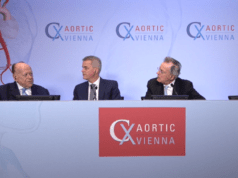
During the CX Aortic Vienna sac size and endovascular aneurysm repair (EVAR) follow-up session, polling revealed that 94% of the audience agreed with the statement “The only thing that matters in post-EVAR surveillance is sac diameter”.
This result followed a presentation by Ian Loftus (London, UK), who showed data supporting this claim. “A large proportion of aneurysms fail to shrink, despite endovascular intervention, and this correlated with a poorer long-term survival,” he explained. “Whilst the rupture risk is important and needs to be reduced to a minimum, excess cardiovascular risk is also vital and should be a target of our surveillance programme. Furthermore, sac expansion should be deemed a therapeutic failure.” Loftus added that surveillance programmes are currently “largely ineffective”.
He argued that things need to change, and stressed the importance of an individualised, ultrasound-based approach to patient surveillance. He added that tablet-based ultrasound technologies, which can be taken to the patient, are the way forward. Loftus ended with a nod towards the DETECT (Detection of EVAR sac expansion using ultrasound surveillance) study, which will look specifically at the use of a novel tablet technology and sac size increase.
Andres Schanzer (Worcester, USA) posited that aneurysm sac behaviour is associated with long-term survival, and that not only sac expansion, but any failure of the sac to regress, is associated with lower long-term survival. Finally, he noted that a decrease in long-term survival effect is independent of identification of endoleak. “We need to better understand if complete aneurysm exclusion is adequate treatment for aneurysm disease,” Schanzer told registrants.
Considering why sac retraction is an important issue after EVAR, Jean-Pierre Becquemin was next to address the CX Aortic Vienna audience. “Since the beginning of EVAR treatment,” he began, “the search for endoleak was the main purpose of postoperative surveillance”. However, Becquemin concluded that detailed that diameter, more than endoleak, is a key factor of surveillance, detailing that failure of sac retraction and or enlargement is associated with impaired overall survival, aneurysm-related survival, more complications, and need for reintervention.

Maarit Venermo (Helsinki, Finland) talked about the Helsinki University Hospital experience of ultrasound surveillance after EVAR. The team began using ultrasound for this purpose in 2011 and have found it to be non-inferior to CT surveillance. Over 10 years, the study group also found that with the new protocol of ultrasound surveillance, there was less radiation, and it was more cost-effective.
Jeffrey Jim (Minneapolis, USA) considered how stent graft design influences overall abdominal aortic aneurysm (AAA) sac dynamics and overall therapy success, and, more specifically, how this applies with respect to the Endurant device (Medtronic). Successful abdominal aortic aneurysm (AAA) therapy with stent grafts have traditionally been determined by factors including freedom from mortality and the absence of endoleaks. However, sac regression and the negative impact of endoleaks on sac regression are now known and important factors, Jim stressed. “The design features of the Endurant likely have an impact on sac dynamics and therapy success,” he stated, concluding that “endograft design plays an important role in success of endovascular AAA therapy and this is something that all practitioners should consider for their patients”.
Prompting discussion among the panellists, Martelli Massimiliano from Lugano, Switzerland asked: “What is the relevant millimetre increase in sac diameter?” to which the consensus response was somewhere around 5mm.
Following extensive dialogue on the importance of sac diameter, Mari Murumets (London, UK) discussed the technical aspects of reliable aortic sac diameter measurement by ultrasound, covering the limitation of ultrasound, common mistakes, how to minimise errors, and remaining challenges. Murumets covered topics including image resolution, sac measurement, and image acquisition.
This session, and all other sessions from day two of CX Aortic Vienna, is available to view on demand. Click here to register and access the recording.













